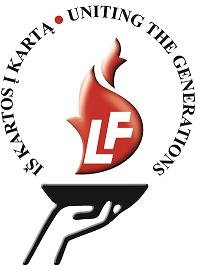Texas
Yorktown, Texas is the home to America’s oldest known Lithuanian community.
Most of the current Lithuanian-Texans, however, are not related to it. The population of Texas skyrocketed recently (from 9 000 000 in 1960 to 26 000 000 today) and Lithuanians were among many migrants the state attracted. Many of them are Lithuanian Americans who moved in from the north. These are, however, new trends and the massively growing Texan cities lack old Lithuanian churches, schools, or memorials.
However, it has been little known that the first Lithuanians moved into Texas in 1852, soon after the Mexican-American war. They moved in from then-German-ruled Lithuania Minor rather than the Russian-occupied and more economically backward Lithuania-proper (where serfdom still existed and migration was thus hampered). Having been raised in a German-dominated society, these Lithuanians then integrated into German-American communities (although their surnames still told of their Lithuanian origins). Together with Germans they also shared a migration goal: to find empty land lots in Texas, after a long journey by ship and then on foot into the interior.

Lithuanians in Texas commemorative plaque near Yorktown
Yorktown Lithuanian cemetery
A key symbol of Yorktown Lithuanian roots has been Smith Creek Lithuanian Cemetery, once overgrown and derelict. It has been restored by the genealogy-interested descendants in the late 20th century. A sign was built, showing it as a Lithuanian cemetery, as well as a painted Lithuanian flag.
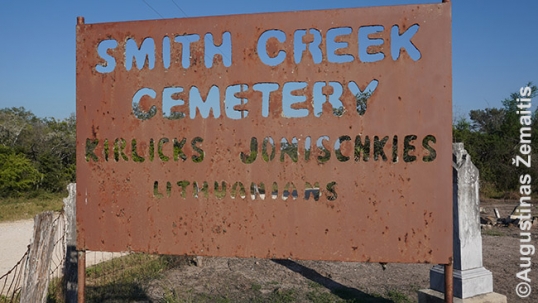
Lithuanian cemetery sign near Yorktown, attributing to the Lithuanian Kirlicks and Jonischkies families
The gravestones were mostly saved as much as they could, however, if parts of them had been completely destroyed, they mostly were not rebuilt, thus the cemetery remaining authentic to its 19th-century roots.
Some 30 tombstones survive fully or partially there though the total number of burials may have been bigger. The cemetery is located near a former village of Smith Creek where many Lithuanians used to live. In many sources, the cemetery after Jonischkies (Joniškis) family who used to own the land. Before Jonischkies, Kerlick family used to own the land, hence the cemetery sign now reads "Smith Creek Cemetery. Kirlicks Jonischkies. Lithuanians.". Several Lithuanian families used to be buried there, as well as at least one German family, based on the ties to the area and Jonischkies.
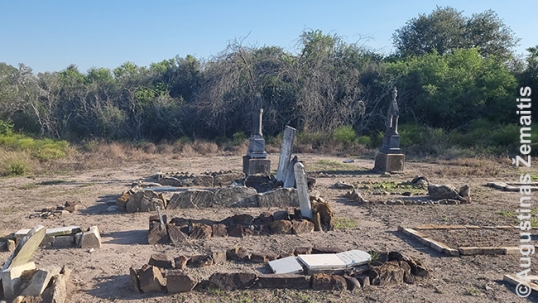
Lithuanian cemetery of Yorktown
Most of the burials there took place in the 19th century, beginning in the 1860s (the oldest tombstone dates to 1864 on a Kerlick grave). The cemetery fell into disuse after a modern cemetery has been built in Yorktown (St. Paul’s); later Lithuanian burials are located there. Until some 1930s, the Smith Creek Lithuanian cemetery was still well-cared for by the descendants of those buried there. However, as the generations who still remembered them passed away themselves, the cemetery became derelict and overgrown. It was discovered as such by people searching their Lithuanian roots in the 1970s.

Lithuanian flag mailbox at Jonischkies cemetery
The inscriptions on the gravestones are mostly German with the remainder being English, despite the same people having talked, read books, and written letters in Lithuanian. This went in line with the situation in Lithuania Minor itself at the time they have left it (before the Lithuanian National Revival). In those days, in Lithuania Minor, German was considered the “prestige language” and thus used for domains such as science or public records even by those whose native language was Lithuanian. Such diglossia was also the reason why the Lithuanian roots of many Yorktown families were obscured for so long, as, without further research, it was easy to believe the (great) grandparents only/mainly spoke German as this was, e.g., the language of their epitaphs.
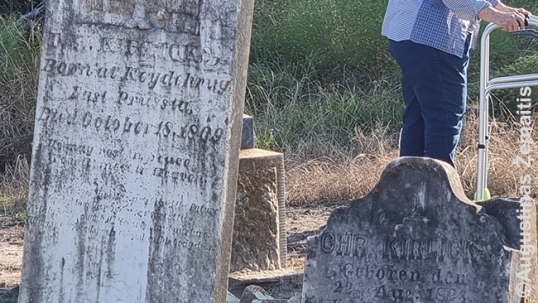
The graves at the cemetery. The left grave lists Heydekrug, East Prussia (modern-day Šilutė, Lithuania) as the place of birth
Yorktown Lithuanian memorial plaque
Some descendants of the early Lithuanian Texans funded a memorial plaque in Yorktown after they had learned of their origins through genealogical research. This is one of just a few Lithuanian-related plaques in the USA and, interestingly, it is located in a town where the 2000 census counted 0 Lithuanians (37% report German ancestry). The plaque reads: "Lithuanians in Texas. Among the many European immigrants arriving in Texas in the mid-19th century was a small group of Lithuanians who settled in the Yorktown vicinity of De Witt County. Due to their eventual assimilation with the numerous German immigrants in the area, the Lithuanians and their contributions to the history of this region were overlooked for generations. Records reveal that the first Lithuanian family to settle in this area probably was that of David and Dora (Scholze) Stanchos. They arrived about 1852, making them among the earliest documented Lithuanian immigrants to America. By 1874 they were joined by about 70 more immigrants, most from the province of Gumbinnen in what was then part of East Prussia. Leaving their homeland for a variety of religious and political reasons, the Lithuanians arrived in Texas primarily through the ports of Galveston and Indianola. Establishing farms in the area, the Lithuanians became American citizens and contributed to the history and culture of this area. Men from the community fought on both sides of the American Civil War. A small graveyard south of Yorktown known as Jonischkies Cemetery contains the interments of many of these early settlers.".
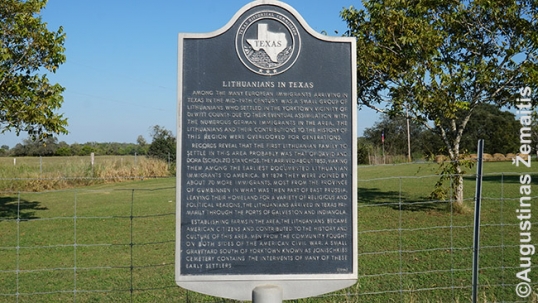
Lithuanians in Texas memorial plaque near Yorktown
Notes: the original Lithuanian surnames of David and Dora Stanchos were likely Dovydas Stančius and Dora Stančienė. The original versions of other anglicized or germanized Texan Lithuanian surnames are: Kirlikas (Kirlikcs), Mertinas (Mertine), Lundšėnas (Lundschen), Ragošius (Ragoszus), Joniškis (Jonischkies), Gelžius (Gelszus), Lenkaitis (Lenkeit), Mastaitis (Mosteit), Vaičys (Weichies), Vaišvila (Weischvill), Gudaitis (Guddaitis). It should be noted that at the time, modern Lithuanian orthography was not yet created, leading Lithuanians to use letters of nearby "prestige languages" when writing their names. E.g. there was no Lithuanian "Š" yet, so Lithuanians used either German "Sch" or Polish "Sz" for the same sound (and may have also adopted English "Sh").
Gumbinnen is the German name of a town known in Lithuanian as Gumbinė. In 1945 this town and surrounding areas were occupied by the Soviet army, its inhabitants (both Germans and Lithuanians) murdered or expelled and then replaced by Russians. The town was renamed Gusev after a Russian communist who died there.
Yorktown Historical Museum
Yorktown Historical Museum has numerous Lithuanian-related exhibits: both those related to Lithuanian culture itself and to the early Lithuanians in Yorktown, e.g. copies Lithuanian-language letters, materials of Lithuanians who worked as freighters in the 19th century, a fishing net brought from Lithuania by Yorktown’s first Lithuania, signs they used to mark their cattle.

Yorktown Historical Museum (part of Lithuanian exhibits)
Due to its unique history and old age, the Yorktown Lithuanian community has attracted disproportional attention from researchers, both Lithuanian-American and Lithuanians from Lithuania (e.g. Vytis Čiubrinskas). A film has been created about the community and numerous books have been written. Some of these books are also available in the museum.

An old Yorktown letter (in Lithuanian) at the Yorktown Historical Museum
A film about the old Texas Lithuanians.
Yorktown Lutheran church
Given they came from Lithuania Minor, the early Yorktown Lithuanians were Lutherans. Together with the local Germans, they participated in building the town’s St. Paul Lutheran church. Originally established in 1874, it had its building replaced by the new one in 1930.
Inside, one may see Lithuanian surnames on some stained-glass windows, e.g. those of Jonischkies family. It was common to add the names of the donors of the church there.
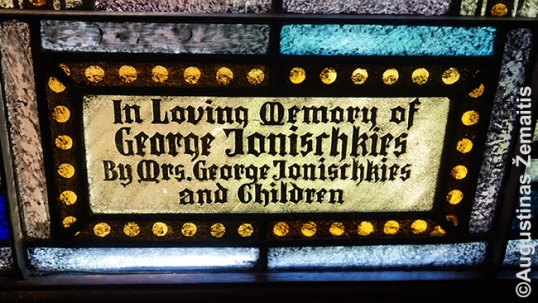
Jonischkies donation inscription on the Yorktown Lutheran church stained-glass windows
Kerlick Street in New Braunfels
As time went by, parts of the Yorktown Lithuanians migrated to other Texan towns such as New Braunfels where one street and a park are named after William Frederick Kelick (Kerlick Lane). He owned 320 acres there and sold it; the city decided to name the street (as well as a nearby park) after him.
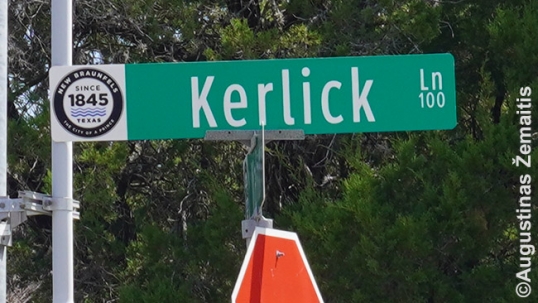
Kerlick Lane in New Braunfels




